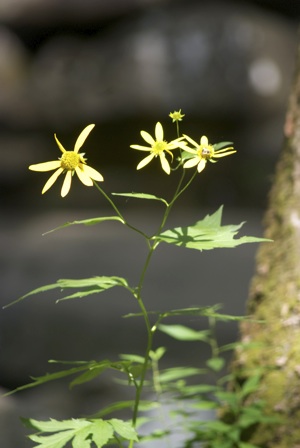Different seasons bring different colors to the Smokies, with daubs of white, yellow, red, blue, and crimson sprinkled among the park's green meadows and forests, depending on the season. With more than 1,600 varieties of flowering plants, you're bound to see some color on your visit.
The flowers you might encounter are, of course, a function of both season and altitude. With a range of elevation from 875 feet (267 m) around Chilhowee Lake on the far western section to Clingmans Dome at 6,643 feet (2,025 m), the climate and growing conditions are both quite varied and quite beneficial to the wide range of plants.

Great Smoky is rich in wildflowers
Spring wildflowers begin to arrive almost before winter is gone, showing up in March when ephemerals raise their stems, leaves, and finally flowers, above the park's floor.
By June mountain laurel blooms throughout the park, and those blooms find themselves competing with those of the Catawba rhododendrons and flame azaleas.
Daffodils also are present in the Smokies, thanks to those homesteaders who enjoyed a little color outside their cabins.
By the time July shows up, so, too, do the blooms on sourwood trees, purple-fringed orchids, and cardinal flower. Come August, bee-balm, Joe-Pye-weed, and pink turtlehead will delight hikers.
Late summer into fall is yet another colorful period in the park, thanks to asters and flowering dogwood, which give way to the arrival of leaf-peeping season.The Smokies boasts the largest stands of old-growth forest in the eastern United States and the greatest biodiversity of any U.S. park (including 100 or so species of trees). This yields a fall outburst of reds, yellows, purples, browns, and golds rivaling those of the New England countryside.
The colors generally peak in mid- to late October at higher elevations (which have a climate similar to New England's), but can start as early as mid-September with the turning of "early" trees like yellow birch, American beech, mountain maple, hobblebush, and pin cherry. At lower and middle elevations, where the color tends to be most spectacular, the blend includes such beauties as sugar maple, scarlet oak, sweetgum, red maple, and hickory.
A good resource for enjoying the park's wildflowers, as well as the rest of its natural history, is A Natural History Guide to Great Smoky Mountains National Park by Donald Linzey.





